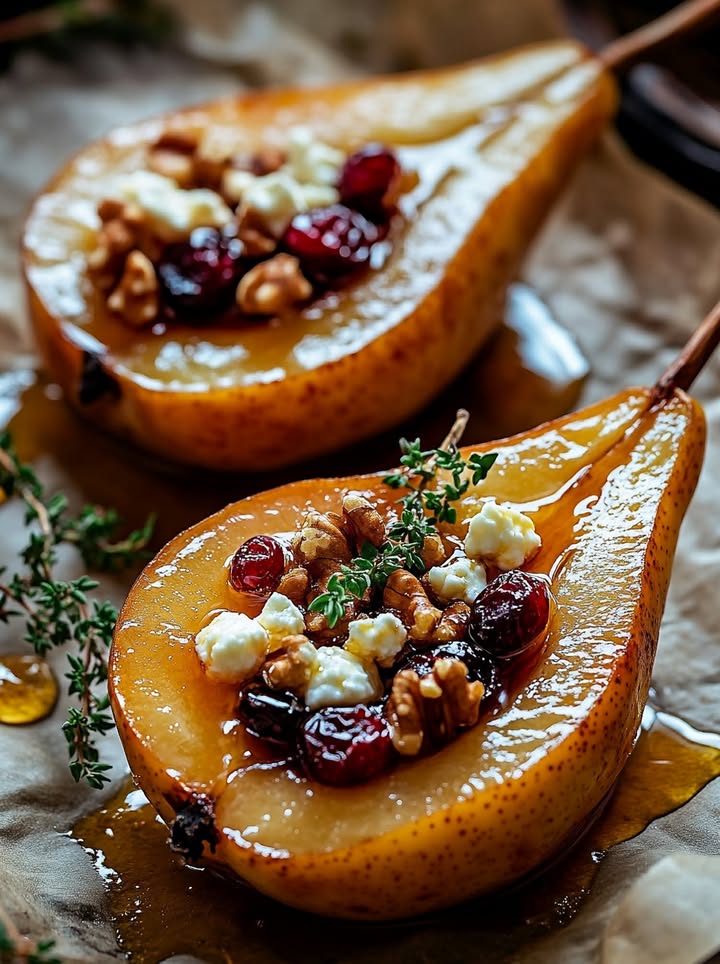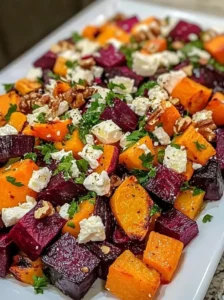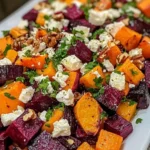Best Baked Pears with Feta, Honey, and Cranberries: A Sweet and Savory Delight
These Best Baked Pears with Feta, Honey, and Cranberries combine sweet and savory flavors for a dish that impresses every time. The tender pears caramelize beautifully in the oven while the tangy feta and tart cranberries create a perfect balance. Drizzled with honey, this recipe delivers a restaurant-quality presentation with minimal effort.
Whether you serve these baked pears as an elegant appetizer or a light dessert, they always steal the show. The warm spices enhance the natural sweetness of the fruit while the cheese adds a creamy contrast. Best of all, this dish comes together in just 30 minutes using simple ingredients you likely already have in your kitchen.
Quick Recipe Highlights
- Flavor Profile: The combination of sweet pears, salty feta, and tart cranberries creates a sophisticated flavor balance that delights the palate.
- Texture: Soft baked pears contrast beautifully with the crumbly cheese and chewy dried cranberries for a satisfying mouthfeel.
- Aroma: Warm cinnamon and honey create an inviting fragrance that fills your kitchen as the pears bake.
- Visual Appeal: The golden-brown pears with white feta and red cranberries make a stunning presentation on any table.
- Skill Level Needed: This recipe requires basic kitchen skills, making it accessible for beginner cooks.
- Special Equipment: You only need a baking dish and a sharp knife for this simple preparation.
Recipe Overview
- Difficulty Level: With just a few simple steps and common ingredients, this recipe falls into the easy category. Even novice cooks can achieve excellent results.
- Category: These baked pears work equally well as an appetizer, side dish, or light dessert for any meal.
- Cuisine: While pears appear in many global cuisines, this preparation draws inspiration from Mediterranean flavor combinations.
- Cost: Using seasonal pears and basic pantry staples keeps this dish budget-friendly for any occasion.
- Season: Although you can make this year-round, autumn and winter showcase pears at their peak sweetness.
- Occasion: These elegant baked pears work for casual weeknight dinners or special holiday gatherings.
Why You’ll Love This Recipe
The Best Baked Pears with Feta, Honey, and Cranberries offer a perfect balance of flavors and textures in every bite. The natural sweetness of ripe pears intensifies during baking while the feta cheese provides a pleasant salty contrast. Meanwhile, the cranberries add bursts of tartness that keep your taste buds engaged throughout the experience.
Preparation couldn’t be simpler for such an impressive dish. After just 10 minutes of hands-on work, the oven does most of the heavy lifting. This makes the recipe ideal for entertaining when you want to spend time with guests rather than laboring in the kitchen. The beautiful presentation looks like you spent hours creating a gourmet masterpiece.
Nutritionally, this dish delivers benefits from all its components. Pears provide fiber and vitamin C while feta offers protein and calcium. The honey adds natural sweetness without refined sugars, and cranberries contribute antioxidants. Together they create a balanced treat that satisfies cravings without excessive calories.
For social gatherings, these baked pears serve as excellent conversation starters. Guests always appreciate the unexpected flavor combination and elegant presentation. You can easily double or triple the recipe for larger parties without significantly increasing your workload. The dish accommodates various dietary needs with simple modifications.
Cost-conscious cooks appreciate how this recipe transforms affordable ingredients into something special. Pears remain reasonably priced throughout their season, and the other components typically live in well-stocked kitchens. The impressive results far exceed what you’d expect from such humble ingredients, making it perfect for budget-friendly entertaining.
Historical Background and Cultural Significance
Pears have graced tables since ancient times, with cultivation records dating back thousands of years. The fruit originated in Asia before spreading to Europe and eventually the Americas. Many cultures prized pears for their sweet flavor and long storage potential compared to other fruits. Baking fruit with cheese and honey has Mediterranean roots where these ingredients have long been staples.
In Greek cuisine, combining fruit with feta cheese creates a classic sweet and savory balance. The addition of honey reflects ancient traditions of using this natural sweetener in both savory and dessert applications. Dried fruits like cranberries became popular later as preservation techniques improved, allowing flavors from different regions to combine in single dishes.
Over time, baked fruit recipes evolved from simple preparations to more elaborate presentations. Modern interpretations often incorporate global influences while maintaining the essential balance of flavors. This recipe represents a contemporary take on traditional combinations that have stood the test of time across multiple cultures.
Regional variations of baked pears appear throughout Europe and North America. Some versions use blue cheese instead of feta while others incorporate nuts or different spices. The cranberries in this recipe add a distinctly North American twist to a preparation with Old World roots. These cultural fusions create exciting new flavor experiences while honoring culinary traditions.
Ingredient Deep Dive
Ripe but firm pears form the foundation of this dish. Bartlett or Anjou varieties work particularly well for baking as they hold their shape during cooking. Look for pears that yield slightly to gentle pressure near the stem for optimal ripeness. Store unripe pears at room temperature until they reach perfect ripeness, then refrigerate to slow further softening.
Feta cheese brings its characteristic tang and saltiness to balance the sweet components. Authentic Greek feta made from sheep’s milk offers the best flavor and texture. For a creamier result, try French feta while Bulgarian varieties tend to be sharper. Store feta in its brine in the refrigerator for up to two weeks to maintain freshness.
High-quality honey makes a noticeable difference in this recipe. Look for raw, unfiltered varieties that retain more complex flavors. The type of honey affects the final taste with orange blossom, wildflower, or clover honey working particularly well. Store honey at room temperature in a sealed container to prevent crystallization.
Dried cranberries provide tart contrast and chewy texture. Choose unsweetened varieties to avoid excessive sweetness or those sweetened with apple juice for a more natural option. For plump cranberries, soak them briefly in warm water before using. Store dried cranberries in an airtight container in a cool, dark place for several months.
Cinnamon adds warmth and depth to the flavor profile. Freshly ground cinnamon from whole sticks offers superior aroma and taste compared to pre-ground versions. Other warming spices like nutmeg or cardamom can complement or replace the cinnamon for variation. Store spices in airtight containers away from heat and light to preserve potency.
Common Mistakes to Avoid
- Using overripe pears that turn mushy during baking rather than maintaining their shape.
- Cutting the pears too thin so they lose structural integrity in the oven.
- Overcrowding the baking dish which prevents even caramelization of the fruit.
- Adding honey before baking which can cause excessive browning or burning.
- Using low-quality feta that lacks the proper tang and texture for balance.
- Skipping the resting time after baking when flavors continue to develop.
- Overbaking the pears until they become too soft and lose their shape.
- Not tasting the feta beforehand as saltiness varies significantly between brands.
Essential Techniques
Proper pear preparation ensures the best texture in your final dish. Cut the pears in half lengthwise and use a melon baller or spoon to carefully remove the core while maintaining the pear’s shape. Leaving a small amount of stem adds visual appeal to the finished presentation. Brush the cut sides with lemon juice to prevent browning if not baking immediately.
Arranging the pears in the baking dish affects how they cook. Place them cut side up with enough space between for air circulation. This positioning allows the cut surfaces to caramelize while the skins help retain moisture. For even cooking, select pears of similar size and ripeness so they finish baking at the same time.
Timing proves crucial for perfect baked pears. They should become tender when pierced with a knife but still hold their shape. The exact baking time varies depending on pear variety and ripeness, so begin checking a few minutes before the suggested time. Remember the pears continue cooking slightly from residual heat after removal from the oven.
Pro Tips for Perfect Best Baked Pears with Feta, Honey, and Cranberries
For extra flavor, toast the feta briefly under the broiler before crumbling it over the pears. This intensifies the cheese’s savory notes and adds subtle crispness. Just watch carefully as feta can burn quickly under high heat.
If your pears aren’t perfectly ripe, add a splash of apple juice or white wine to the baking dish. The liquid creates steam that helps soften the fruit while adding another layer of flavor. The small amount evaporates during baking without making the dish soggy.
For a more complex flavor profile, infuse your honey with herbs or spices before drizzling. Warm the honey gently with rosemary, thyme, or vanilla bean then strain before using. This simple step elevates the dish with minimal extra effort.
Consider adding chopped toasted nuts for additional texture contrast. Walnuts, pecans, or pistachios complement the other flavors beautifully. Toast them lightly to enhance their nuttiness before sprinkling over the finished dish.
For entertaining, prepare the pears through the baking step ahead of time. Reheat gently just before serving, then add the cheese, cranberries, and honey. This maintains optimal textures while reducing last-minute preparation stress.
If serving as dessert, pair with a scoop of vanilla ice cream or Greek yogurt. The cool creaminess provides a delightful contrast to the warm spiced pears. For an adult version, drizzle with a dessert wine reduction instead of plain honey.
Variations and Adaptations
For a winter holiday version, add warming spices like nutmeg, allspice, or cardamom to the cinnamon. Garnish with pomegranate arils instead of cranberries for festive color and flavor. A sprinkle of orange zest brightens the dish beautifully.
Summer variations might feature fresh berries instead of dried cranberries. Blueberries or raspberries work particularly well when in season. Consider adding fresh mint leaves for a refreshing herbal note that complements the fruit.
Dietary adaptations easily accommodate various needs. For vegan versions, substitute coconut yogurt or almond feta for the dairy cheese. Maple syrup or agave nectar can replace honey for strict plant-based diets. Gluten-free guests can enjoy this dish as written.
For a more savory take, add fresh thyme or rosemary to the baking pears. Top with crumbled bacon or prosciutto along with the cheese for a heartier appetizer version. A balsamic glaze drizzle adds sophisticated acidity.
Texture modifications might include adding granola or crushed amaretti cookies for crunch. For smoother texture, blend some baked pears into a puree to serve beneath the intact halves. This creates an elegant restaurant-style plating.
Serving and Presentation Guide
Plating these baked pears beautifully enhances their visual appeal. Arrange them on a neutral-colored platter or individual plates with the cut sides up. Drizzle the honey in a zigzag pattern across all the pears for professional-looking presentation.
Garnishing strategically elevates the dish. Sprinkle the feta and cranberries evenly across all servings rather than piling them in one spot. Add a few whole cranberries and small feta crumbles as finishing touches for visual interest.
Traditional accompaniments include crusty bread or crackers to scoop up any remaining honey and cheese. For dessert service, vanilla ice cream or whipped cream makes an indulgent pairing. A simple green salad balances the flavors when served as an appetizer.
Modern serving suggestions might include layering the components in a glass for a deconstructed presentation. Alternatively, slice the baked pears and fan them on the plate with other elements artfully arranged around them.
Temperature considerations affect enjoyment. Serve the pears warm but not piping hot to allow all flavors to shine. If preparing ahead, bring to room temperature before serving or gently rewarm in a low oven.
Portion control comes naturally with this dish as each pear half makes a perfect single serving. For lighter appetites or more courses, one pear half per person suffices. Heartier appetites may appreciate two halves with appropriate accompaniments.
Wine and Beverage Pairing
Wine pairings should complement both the sweet and savory elements of this dish. A slightly sweet Riesling or Gewürztraminer balances the flavors beautifully. For red wine lovers, a light Pinot Noir works well without overwhelming the delicate pears.
Non-alcoholic alternatives might include sparkling apple cider or pear nectar. Herbal teas like chamomile or mint make excellent pairings, especially for dessert service. A honey-sweetened lemonade offers refreshing contrast.
For coffee pairings, choose a medium roast with low acidity to avoid clashing with the fruit. A vanilla latte or mocha complements the sweet components while the coffee’s bitterness cuts through the richness.
Temperature considerations matter for beverage pairings. Serve white wines and non-alcoholic options well chilled while reds should be slightly cooler than room temperature. Hot beverages should be served piping hot to contrast with the warm pears.
Serving suggestions include offering several pairing options when entertaining. This allows guests to choose their preference and creates conversation about how different beverages interact with the flavors.
Storage and Shelf Life
Storage methods vary depending on how far in advance you prepare components. Baked pears without toppings keep refrigerated for up to three days in an airtight container. The cheese and cranberries should remain separate until serving for best texture.
Temperature requirements differ by component. Store baked pears in the refrigerator but bring to room temperature before serving. Feta should always stay refrigerated while dried cranberries prefer cool, dry storage.
Container recommendations include glass or BPA-free plastic with tight-fitting lids. For partial preparations, separate components prevent sogginess or flavor transfer. Parchment paper between layers protects delicate pear surfaces.
Signs of spoilage include excessive liquid in the container, off odors, or mold growth. The pears may darken slightly during storage but this doesn’t affect safety. Discard if you notice any questionable changes in appearance or smell.
Reheating instructions suggest gentle warming in a 300°F oven for 10-15 minutes. Microwave reheating can make the pears mushy, though brief warming works in a pinch. Always add fresh toppings after reheating.
Freezing guidelines recommend freezing baked pears without toppings for up to two months. Thaw overnight in the refrigerator before reheating. The texture softens slightly but remains acceptable for most uses.
Make Ahead Strategies
Prep timeline flexibility makes this recipe ideal for entertaining. You can prepare the pears through baking up to two days in advance. Store them properly then simply add toppings when ready to serve.
Storage between steps requires keeping components separate. The baked pears refrigerate well while the feta and cranberries should remain at room temperature in airtight containers. Prepare the honey drizzle but keep it separate until serving.
Quality impact assessment shows minimal degradation when following proper make-ahead techniques. The pears may soften slightly but retain good flavor. Fresh toppings added just before serving maintain optimal textures.
Assembly tips for make-ahead versions suggest bringing all components to appropriate temperatures before combining. Cold pears mute flavors while room temperature ingredients showcase them best. A quick warm-up in a low oven revives the pears if needed.
Reheating guidelines for make-ahead preparations recommend gentle warming to preserve texture. Cover the pears loosely with foil to prevent drying out. Check frequently to avoid overheating.
Fresh element additions should always happen just before serving. This maintains the cheese’s texture and prevents the cranberries from becoming too soft. Drizzle the honey at the last moment for maximum visual appeal.
Scaling Instructions
Halving the recipe works perfectly for smaller gatherings. Use a smaller baking dish to maintain proper spacing between pear halves. Reduce baking time slightly as the oven won’t be as full.
Doubling or tripling requires multiple baking dishes or working in batches. Ensure adequate air circulation around each pear half for even cooking. Rotate dishes in the oven if baking simultaneously on different racks.
Equipment adjustments may include using rimmed baking sheets instead of dishes for larger quantities. The increased surface area promotes better caramelization when making big batches.
Timing modifications become necessary when scaling. Larger quantities may require slightly longer baking while smaller batches often cook faster. Begin checking for doneness a few minutes early when adjusting quantities.
Storage considerations change with scaling. Larger batches may require more refrigerator space for make-ahead preparations. Divide into smaller containers for easier handling and more even cooling.
Nutritional Deep Dive
Macro breakdown reveals a balanced profile from this dish. The pears provide carbohydrates and fiber while the feta contributes protein and fat. Honey adds natural sugars but in moderate amounts when portioned properly.
Micronutrient analysis shows significant vitamin C from the pears along with calcium from the cheese. Cranberries add antioxidants while the honey provides trace minerals. Cinnamon contributes beneficial plant compounds.
Health benefits include improved digestion from the fiber and potential anti-inflammatory effects from the various components. The combination of nutrients supports immune function and provides sustained energy.
Dietary considerations accommodate various needs naturally. The recipe contains no gluten or nuts, making it suitable for those restrictions. Dairy can be modified for lactose intolerance or vegan diets.
Portion analysis shows reasonable calorie counts per serving when enjoyed as part of a balanced meal. The natural sweetness satisfies cravings without excessive added sugars common in desserts.
Weight management tips include enjoying this as a dessert replacement for higher-calorie options. The fiber and protein promote satiety while the flavors satisfy sweet cravings in a nutritious package.
Dietary Adaptations
Gluten-free needs require no modifications as the recipe contains no gluten-containing ingredients. Always check labels on processed components like cheese or dried fruit for hidden gluten sources.
Dairy-free versions can substitute vegan feta or omit the cheese entirely. Nutritional yeast sprinkled over the top adds a cheesy flavor without dairy. Coconut yogurt provides creamy contrast.
Vegan adaptations replace both the honey and cheese. Maple syrup works well as a honey substitute while almond or cashew-based cheeses mimic feta’s texture. Ensure dried cranberries don’t contain honey.
Low-carb modifications might reduce the honey quantity or use a sugar-free substitute. Focus on the cheese and pear components while minimizing higher-carb toppings.
Keto versions require significant modification as pears contain natural sugars. Consider using lower-carb fruit like berries instead or keeping portions very small to stay within macros.
Paleo adaptations focus on removing dairy and processed ingredients. Coconut products can replace the cheese while raw honey fits within paleo guidelines when used sparingly.
Low-FODMAP versions should use firm, slightly underripe pears which contain less problematic sugars. Limit honey quantity and ensure cranberries don’t contain high-FODMAP sweeteners.
Troubleshooting Guide
Texture issues often stem from pear selection or baking time. If pears turn mushy, they were likely overripe or baked too long. For tough pears, extend baking time in five-minute increments until tender.
Flavor balance problems may require adjusting component quantities. If too sweet, increase the feta or add lemon juice. If too savory, add more honey or cranberries to taste.
Temperature problems usually involve serving components too cold or hot. Let refrigerated pears come to room temperature or warm gently. Serve immediately after adding toppings for ideal temperatures.
Equipment challenges might include inadequate baking dishes. If pears don’t fit properly, use multiple smaller dishes rather than overcrowding. Uneven cooking may require rotating dishes in the oven.
Ingredient substitutions sometimes affect results. Different pear varieties bake differently while cheese alternatives vary in saltiness and meltability. Adjust other components accordingly when substituting.
Timing concerns often relate to oven variations. If edges brown too quickly, cover loosely with foil. For insufficient browning, increase temperature slightly or broil briefly at the end.
Recipe Success Stories
Community feedback consistently praises this recipe’s simplicity and impressive results. Many home cooks report receiving compliments when serving these baked pears to guests. Several have made the dish a regular part of their holiday menus.
Variation successes include creative adaptations like adding nuts or different spices. Some cooks enjoy experimenting with various cheese options from gorgonzola to goat cheese. The basic recipe proves endlessly adaptable to personal tastes.
Adaptation stories highlight how easily the recipe accommodates dietary needs. Gluten-free and vegan friends appreciate being included without special preparation. Many report the dish becoming a family favorite across generations.
Reader suggestions often focus on presentation ideas. Some arrange the pears on a bed of greens while others serve in individual ramekins. Creative drizzling techniques with the honey inspire many beautiful photos.
Photography tips emphasize natural lighting to capture the golden hues. Overhead shots showcase the beautiful arrangement while close-ups highlight the texture contrasts. Many food bloggers feature this recipe in autumn content.
Frequently Asked Questions
Can I use canned pears instead of fresh? While possible, canned pears often become too soft during baking. If using canned, choose firm-packed varieties and reduce baking time significantly. Fresh pears yield far superior texture and flavor.
What’s the best substitute for feta cheese? Goat cheese or blue cheese make excellent alternatives with similar tangy profiles. For milder flavor, try ricotta salata or even fresh mozzarella in small pieces.
Can I make this recipe without honey? Absolutely. Maple syrup, agave nectar, or even a balsamic reduction work well as substitutes. Adjust quantity to taste based on the sweetener’s intensity.
How do I know when the pears are perfectly baked? The pears should yield easily to a knife but still hold their shape. The flesh near the core becomes translucent when properly cooked through.
Can I prepare this dish completely in advance? You can bake the pears ahead but add toppings just before serving for best texture. The assembled dish tastes best fresh.
What’s the best way to reheat leftovers? Gently warm in a 300°F oven for about 10 minutes. Microwaving can make the pears mushy though it works in a pinch.
Can I freeze the baked pears? Yes, though the texture softens slightly. Freeze without toppings then refresh in the oven after thawing. Best consumed within two months.
What other fruits work in this preparation? Apples, peaches, and nectarines all bake beautifully with similar treatment. Adjust baking times based on the fruit’s density and ripeness.
How can I make this recipe more savory? Add fresh herbs like thyme or rosemary to the baking pears. Top with crispy prosciutto or pancetta along with the cheese.
What’s the best way to serve this for a party? Arrange on a large platter for self-service or prepare individual portions in small dishes. Provide serving utensils for easy topping distribution.
Additional Resources
Related recipes might include other baked fruit desserts or savory fruit preparations. Consider exploring poached pears, fruit and cheese boards, or stuffed apple variations for similar flavor profiles.
Technique guides for working with fresh fruit can improve your results. Learn proper pear selection, knife skills for fruit preparation, and baking fundamentals to master this and similar recipes.
Ingredient information helps when selecting components. Research different pear varieties, cheese types, and honey varieties to understand how they affect your finished dish.
Equipment recommendations might include quality baking dishes, sharp knives, and proper storage containers. Investing in good tools makes preparation easier and improves results.
Seasonal variations allow you to enjoy this concept year-round. Adapt the recipe with whatever fruit shines each season while maintaining the sweet-savory balance that makes it special.
PrintBest Baked Pears with Feta, Honey, and Cranberries
Description
A delightful combination of sweet and savory flavors, these baked pears are topped with creamy feta, drizzled with honey, and sprinkled with tart cranberries for a perfect appetizer or dessert.
Ingredients
For the Crust:
- 4 ripe pears, halved and cored
- 1/2 cup crumbled feta cheese
- 1/4 cup dried cranberries
- 2 tablespoons honey
- 1 tablespoon olive oil
- 1/2 teaspoon cinnamon
- 1/4 teaspoon black pepper
Instructions
1. Prepare the Crust:
- Preheat the oven to 375°F (190°C). Line a baking sheet with parchment paper.
- Place the pear halves on the baking sheet, cut side up. Drizzle with olive oil and sprinkle with cinnamon and black pepper.
- Bake for 20-25 minutes until the pears are tender. Remove from the oven and top with feta cheese and cranberries. Drizzle with honey and serve warm.
Notes
You can customize the seasonings to taste.









